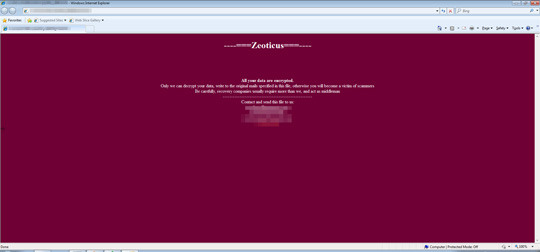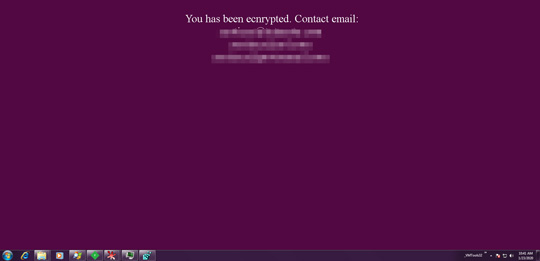Ransom.Win32.ZEOTICUS.B
Mal/EncPk-ACW (SOPHOS_LITE), BScope.Trojan.Winlock (VBA32)
Windows


Threat Type: Ransomware
Destructiveness: No
Encrypted: No
In the wild: Yes
OVERVIEW
This Ransomware arrives on a system as a file dropped by other malware or as a file downloaded unknowingly by users when visiting malicious sites.
It drops files as ransom note.
TECHNICAL DETAILS
Arrival Details
This Ransomware arrives on a system as a file dropped by other malware or as a file downloaded unknowingly by users when visiting malicious sites.
Installation
This Ransomware drops the following copies of itself into the affected system:
- %Windows%\{Malware Name}.exe
(Note: %Windows% is the Windows folder, where it usually is C:\Windows on all Windows operating system versions.)
It adds the following processes:
- bcdedit.exe /set {current} nx AlwaysOff → Disable Data Execution Prevention
- wbadmin delete catalog -quiet → deletes backup catalog
- vssadmin.exe delete shadows /all /quiet → deletes shadow copies
- wmic SHADOWCOPY DELETE → deletes shadow copies
It adds the following mutexes to ensure that only one of its copies runs at any one time:
- {GUID};{OS Version} {Username};{BLOCKED}us@{BLOCKED}ta.com;emVvdGljdXM=
Autostart Technique
This Ransomware adds the following registry entries to enable its automatic execution at every system startup:
HKEY_CURRENT_USER\Software\Microsoft\
Windows\CurrentVersion\Run
{Malware Name}.exe = %Windows%\{Malware Name}.exe
Other System Modifications
This Ransomware adds the following registry entries:
HKEY_CURRENT_USER\Software\Microsoft\
Windows\CurrentVersion
{Random Characters} = {Random Characters}
It changes the desktop wallpaper by modifying the following registry entries:
HKEY_CURRENT_USER\Control Panel\Dekstop
Wallpaper = %User Temp%\{GUID}.jpg
It sets the system's desktop wallpaper to the following image:
Other Details
This Ransomware connects to the following possibly malicious URL:
- http://{BLOCKED}x.xyz/supersecretstring?babyDontHeartMe={Obfuscated Mutex}
It does the following:
- It encrypts files located in the following locations:
- Removable
- Fixed
- Network
Ransomware Routine
This Ransomware avoids encrypting files with the following strings in their file path:
- ProgramData
- IETldCache
- Boot
- Program Files
- Program Files (x86)
- Tor Browser
- Windows
- Local Settings
It avoids encrypting files found in the following folders:
- desktop.ini
- autorun.inf
- ntuser.dat
- iconcache.db
- bootsect.bak
- boot.ini
- ntuser.dat.log
- thumbs.db
- READ_ME.html
- ntldr
- NTDETECT.COM
It appends the following extension to the file name of the encrypted files:
- .id-{GUID}.{BLOCKED}us@{BLOCKED}ta.com.zeoticus
It drops the following file(s) as ransom note:
- {Encrypted Directory}\READ_ME.html

SOLUTION
Step 1
Trend Micro Predictive Machine Learning detects and blocks malware at the first sign of its existence, before it executes on your system. When enabled, your Trend Micro product detects this malware under the following machine learning name:
- Troj.Win32.TRX.XXPE50FFF033
Step 2
Before doing any scans, Windows 7, Windows 8, Windows 8.1, and Windows 10 users must disable System Restore to allow full scanning of their computers.
Step 3
Note that not all files, folders, and registry keys and entries are installed on your computer during this malware's/spyware's/grayware's execution. This may be due to incomplete installation or other operating system conditions. If you do not find the same files/folders/registry information, please proceed to the next step.
Step 4
Restart in Safe Mode
Step 5
Delete this registry value
Important: Editing the Windows Registry incorrectly can lead to irreversible system malfunction. Please do this step only if you know how or you can ask assistance from your system administrator. Else, check this Microsoft article first before modifying your computer's registry.
- In HKEY_CURRENT_USER\Software\Microsoft\Windows\CurrentVersion
- {Random Characters} = {Random Characters}
- {Random Characters} = {Random Characters}
- In HKEY_CURRENT_USER\Software\Microsoft\Windows\CurrentVersion\Run
- {Malware Name} = %Windows%\{Malware Name}
- {Malware Name} = %Windows%\{Malware Name}
Step 6
Search and delete this file
- %Windows%\{Malware Name}.exe
- {Encrypted Directory}\READ_ME.html
- %User Temp%\{GUID}.jpg
Step 7
Restart in normal mode and scan your computer with your Trend Micro product for files detected as Ransom.Win32.ZEOTICUS.B. If the detected files have already been cleaned, deleted, or quarantined by your Trend Micro product, no further step is required. You may opt to simply delete the quarantined files. Please check this Knowledge Base page for more information.
Step 8
Reset your Desktop properties
Step 9
Restore encrypted files from backup.
Did this description help? Tell us how we did.



